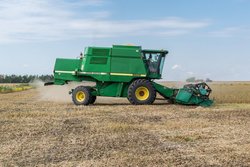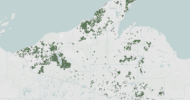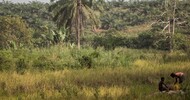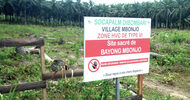
Open Democracy | 12 October 2021
The soya curse: Is Ukraine facing the same fate as the Amazon?
by Hans Wetzels
“GM seeds must have been smuggled into the country, because it is not permitted to grow genetically modified soya in Ukraine.” Volodymyr Onatskyi runs a small company selling manure and seeds to farmers in eastern Ukraine. He is increasingly worried about the pace with which big conglomerates are buying up fertile land in the country, depleting soils and polluting fresh water sources by their massive use of chemicals.
Villagers also believe the big farms are illegally planting genetically modified (GM) soya. “The big companies plant them anyway, and in the process contaminate the fields of conventional farmers. That’s what people around here suspect, at least. Because finding out what’s really going on is often very difficult in a country like Ukraine,” Onatskyi said.
As part of its Green Deal, the European Union is trying to move soya production from Brazil to eastern Europe. But with the market controlled by oligarchs and multinational corporations, there are question marks over whether such a move will really benefit either local communities or the environment.
Fertile soil, cheap land, strategic location
Ukraine was historically known as the granary of the Russian Empire and later the Soviet Union. By the end of the 19th century, companies such as US giant Cargill and Parisian trading house Louis Dreyfus were making their fortunes in the country. They constructed silos, purchased milling companies and built ships to transport cheap Ukrainian grain to growing industrial towns in Britain and France.
Fast forward to 2006, and a joint report by the United Nations Food and Agriculture Organization (FAO) and the European Bank for Reconstruction and Development (EBRD) predicted that the fertile soils of the Eurasian heartland – stretching all the way from Romania and Ukraine through Russia into Kazakhstan – would feed the world for decades to come.
Agriculture in Ukraine happens on a giant scale. Most farming businesses are fully integrated conglomerates owned by billionaire oligarchs, operating their own train networks, fleets of often unmarked trucks and storage facilities around the country.
Ten companies control 71% of the agricultural market in Ukraine, Ukrainian Grain Association (UGA) statistics show. In addition to the Ukrainian oligarchy, multinational corporations such as Archer Daniels Midland (ADM), Bunge, Cargill, Louis Dreyfus, and the Chinese state-owned company COFCO, are all active players.
In recent years, international agro-industrial giants including Cargill and Bunge have invested millions of dollars in increased production capacity in the country. Extremely fertile soils, cheap land and a strategic location between export markets in Europe, China and the Middle East have also put Ukraine in the spotlight of land investors.
Ukraine became even more interesting for agricultural investors after the EU-Ukrainian Association Accord was signed in 2014, and especially after the European Commission launched its EU Protein Plan in 2018. The plan announced the commission’s aim to shift soya production from South America into European territory.
Protein Plan and Green Deal
There are multiple reasons for the commission’s plan. Soya beans were previously used primarily to produce vegetable oils, but their market value rocketed when what remained after oil production started being used as a source of cheap protein in animal feed in the 1960s. Since then, the amount of soya grown worldwide has expanded sixfold. Most of it comes from the Americas and nearly half from Brazil and Argentina. Soya production in Brazil has quadrupled in 20 years.
But since the rise to power of President Bolsonaro and the Brazilian extreme Right in 2019, ever bigger swathes of the ecologically vulnerable Amazon rainforest are burned down to make way for soya plantations, highways are built through the ancestral forests of Indigenous peoples, and activists are increasingly targeted by loggers and farmers.
The EU Protein Plan was swiftly followed by the launch of the European Green Deal in 2019. This political masterplan to make Europe climate-neutral by 2050 has, among other things, made shifting protein production from environmentally unfriendly Brazil to Europe an even bigger priority. To this end, the European Commission is developing legislative proposals and targeted subsidies through the EU Common Agricultural Policy (CAP), to stimulate European farmers to start planting legumes. To grow sufficient quantities of soya to feed the European livestock industry, the fertile soils in the east of the continent are crucial.
Friends of the Earth warns that too fast a shift will just move problems associated with soya cultivation in South America to countries in eastern Europe – where sustainability standards and legislative frameworks remain weak, and corruption is rife. There are increasing concerns about big farmers grabbing land, deforestation and pollution of the soil and water from the overuse of chemicals.
Ukraine is already Europe’s soya superpower, producing 3.9 millions tons per year – some way behind the global powerhouses of Brazil and the United States. Strings of murky land deals allowing Ukrainian conglomerates to grow to unprecedented sizes have strengthened calls from campaigners for the EU to remain cautious about increased dependency on Ukrainian or Romanian soya.
GM contamination
Exports of illegal GM soya from Ukraine into the EU are also a concern. Under current biosafety laws in Ukraine it is not allowed to grow unregistered GM crops. However, since there is no regulatory framework for approval and registration for GM technology, no genetically modified crops are allowed for cultivation.
However, field research by the Romanian NGO Agent Green and the Austrian government’s Environmental Institute shows that up to half of all soya exported from Ukraine could be illegally grown GM crops. The United States Department of Agriculture (USDA) puts it higher still: it estimates, on the basis of ‘industry rumours’, that up to 65% of all Ukrainian soya exports could be illegal. Research samples commissioned by the ecologically certified German supermarket Bio Landmarkt have also tested positive for GM contamination.
For Ukrainian seed merchant Volodymyr Onatskyi, this comes as no surprise: “We suspect that the first genetically modified soya was smuggled into Ukraine by a big poultry producer to grow cheaper fodder. Small farmers selling their produce on local markets are now surrounded by plantations growing GM soya, run by conglomerates. Farmers are starting to ask themselves how they will ever be able to pass on fertile soils to their children.”
Currently, there are no formal sanctions in place for farmers caught growing unregistered GM soya in Ukraine. While some traders choose to hire private agencies to check their cargos for GM contamination, customs checks at Ukrainian ports do not include inspecting for GM. A new draft law to regulate GM activities, presented to the Ukrainian parliament in August 2021, could better the chances for GM-free soya.
A clean soya chain
The EU’s plans to expand soya production eastwards offer economic opportunities, according to Volodymyr Pugachov of Austria’s Donau Soja, which wants to stimulate soya cultivation across countries between the River Danube and the Black Sea.
“Everybody in Ukraine knows that illegal GM soya is being cultivated on a very large scale,” Pugachov said. “That should show us that soya cultivation in Ukraine is not without risk. We try to teach farmers how to grow soya in a sustainable way, without using genetically modified varieties, taking good care of the soil and without unnecessary chemicals. After all, Europe is a big market and most consumers there prefer non-GM food.”
Working with six major Ukrainian producers, Donau Soja hopes to establish a clean soya chain using a new certification system. A Donau Soja-certified farmer should not chop down trees or use pesticides, should pay farm workers a sufficient wage and is not allowed to plant GM crops.
‘Agricultural bonanza’?
The biggest soya producers in Ukraine all deny having anything to do with illegal GM exports. Chemical giant and GM developer Bayer-Monsanto considers Ukraine a quarter of its entire European market – but a spokesperson denies any knowledge of genetically modified seeds being used in the country and says the conglomerate has no “active patents on GM soya in Ukraine”.
Major companies are, however, also hoping for a change in legislation when it comes to growing GM soya in Ukraine. John Shmorhun, a former US Navy fighter pilot, was until 2020 CEO of the multinational AgroGeneration and is now a board member. AgroGeneration has been busy buying land in Ukraine since 2009 – partly to plant soya – and is funded by the US private equity firm SigmaBleyzer.
Shmorhun points at a large map hanging behind him: “Right now, we operate about 60,000 hectares. There are a lot of wild stories about the lawlessness in Ukrainian agriculture. But from our point of view it’s just a shame that genetically modified crops are not permitted in Ukraine. If the Ukrainian government would manage to create an investment environment more friendly to foreign business, this country can expect a true agricultural bonanza.”
Whether farming communities in Ukraine would benefit from such a bonanza remains to be seen. Romanian activist and farmer Attila Szocs from grassroots campaign group Eco Ruralis has his doubts. Even if soya is certified as non-GM, said Szocs, “it still doesn’t change this industrialised universe of cheap meat, big retailers, international traders and unsustainable monocultures. Farmers in rural Ukraine or Romania don’t benefit. Instead, local economies get obliterated and people move to the West to work underpaid jobs, processing the food that then gets exported back to Romania where it is sold in supermarket chains owned by Germans.”
While regulation and certification might be steps in the right direction, for Szocs there are more entrenched problems: “The system is still based on the perverse economic bias that eastern Europe can be used to produce cheap commodities for megafarms in Germany or the Netherlands.” For many, a real ‘Green Deal’ will require transforming that system.













